- Quick Read
- Deep Read ( 8 Min. )

Why is Christian Science in our name?
Our name is about honesty. The Monitor is owned by The Christian Science Church, and we’ve always been transparent about that.
The Church publishes the Monitor because it sees good journalism as vital to progress in the world. Since 1908, we’ve aimed “to injure no man, but to bless all mankind,” as our founder, Mary Baker Eddy, put it.
Here, you’ll find award-winning journalism not driven by commercial influences – a news organization that takes seriously its mission to uplift the world by seeking solutions and finding reasons for credible hope.
Explore values journalism About usIn Today’s Issue
- It’s not just an election that divides America, it’s where to go for facts
- US, China, Taiwan: Why the tense status quo may stick – for now
- On college campuses, one surprising relief from pandemic stress: friends
- Black, trans, and hopeful. Meet Jevon Martin (video)
- Bank shot: A sports writer and a superfan bond over Knicks basketball
Monitor Daily Podcast
- Follow us:
- Apple Podcasts
- Spotify
- RSS Feed
- Download
TODAY’S INTRO
What is President Trump really thinking?
It is a trap that White House correspondents risk falling into: claiming to know what President Donald Trump is thinking. We know what he says publicly and sometimes we can deduce his mood, as when he spoke to journalists, myself included, on Air Force One after the Oct. 22 debate in Nashville. He was “chatty, even ebullient,” I wrote afterward.
But did President Trump really think he might win the election? It’s hard to say. Perhaps he was projecting confidence but harboring doubts. Fast forward to today with the president making unsubstantiated claims of widespread fraud – debunked by his own government – and questions around Mr. Trump’s inner dialogue become far more consequential. Is he actually trying to steal the election? Or maybe, “by dominating the story of his exit from the White House, he hopes to keep his millions of supporters energized and engaged for whatever comes next,” as New York Times reporter Maggie Haberman suggests, citing insider sources.
“The president has insisted to aides that he really defeated Joseph R. Biden Jr. on Nov. 3, but it is unclear whether he actually believes it,” she writes.
Curiosity about Mr. Trump, this most unusual of American presidents, is widespread. In a Zoom session yesterday with journalism students at the University of Memphis, I was peppered with questions about covering Mr. Trump. I told them, as future reporters, that it’s wise not to make assumptions. And while this president says a lot publicly – whether in person or by tweet – we often can’t take his statements at face value.
Share this article
Link copied.

Help fund Monitor journalism for $11/ month
Already a subscriber? Login

Monitor journalism changes lives because we open that too-small box that most people think they live in. We believe news can and should expand a sense of identity and possibility beyond narrow conventional expectations.
Our work isn't possible without your support.
It’s not just an election that divides America, it’s where to go for facts
The aftermath of Election Day has featured not just a political battle over the outcome; it has also put on display an American electorate riven over where to turn for facts and trustworthy information.
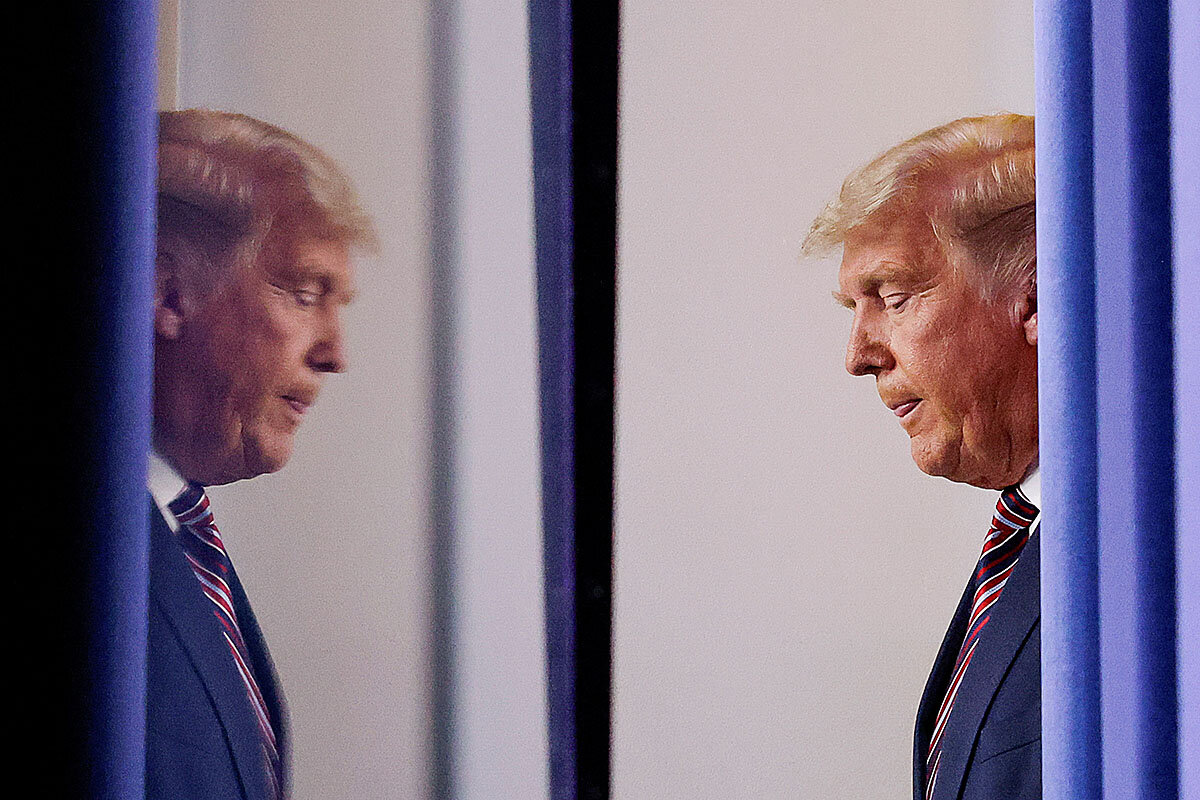
-
Nick Roll Staff writer
-
Richard Mertens Correspondent
For Pat Ring in Bristol, Wisconsin, even Fox News is now a tainted source, after the network was the first to project Democrat Joe Biden the winner of Arizona – just before President Donald Trump was reportedly preparing to declare victory.
“I’ll never listen to Fox again,” says Mr. Ring, sitting at his dining room table with his wife and granddaughter.
Mr. Ring’s view reflects a phenomenon that’s been building for over a decade, as the country’s stark political divisions are bolstered in part by “media silos” that isolate Americans from one another. This may help explain why, despite evidence that Mr. Biden has won, one postelection poll of registered voters finds most Republicans do not believe the presidential election was free and fair.
If there is a silver lining to lawsuits the Trump campaign has filed, it may be that those provide a chance for assurance that competing claims have been heard.
Katlyn Carter, a Notre Dame University historian, says, “It’s a very dangerous situation because there is no quick remedy to rebuild trust when it has eroded to such an extent that not only facts, but the very processes of establishing them, are contested.”
It’s not just an election that divides America, it’s where to go for facts
A few mornings ago, when Mary Ring’s granddaughter asked her, “Are you sad that Biden won?” the Kenosha County resident was quick to respond.
“No,” Ms. Ring gently told her, “because he hasn’t won.”
She and her husband, Pat, are ardent supporters of President Donald Trump, and 10 days after the election, their front lawn in Bristol, Wisconsin, is still festooned with the president’s signs. But like a number of families across a country sharply divided by politics, their adult children, including their granddaughter’s parents, voted for President-elect Joe Biden.
Their political differences with their children aren’t simply a matter of contrasting values, she and her husband say. They are also about the fundamental facts they believe to be true – like the claims of widespread voter fraud the president continues to allege.
“They think we have misinformation,” says Ms. Ring, who, like her husband, have been loyal watchers of Fox News for years. “We say they’re misinformed,” she says, noting that their grown-up kids watch MSNBC and listen to podcasts.
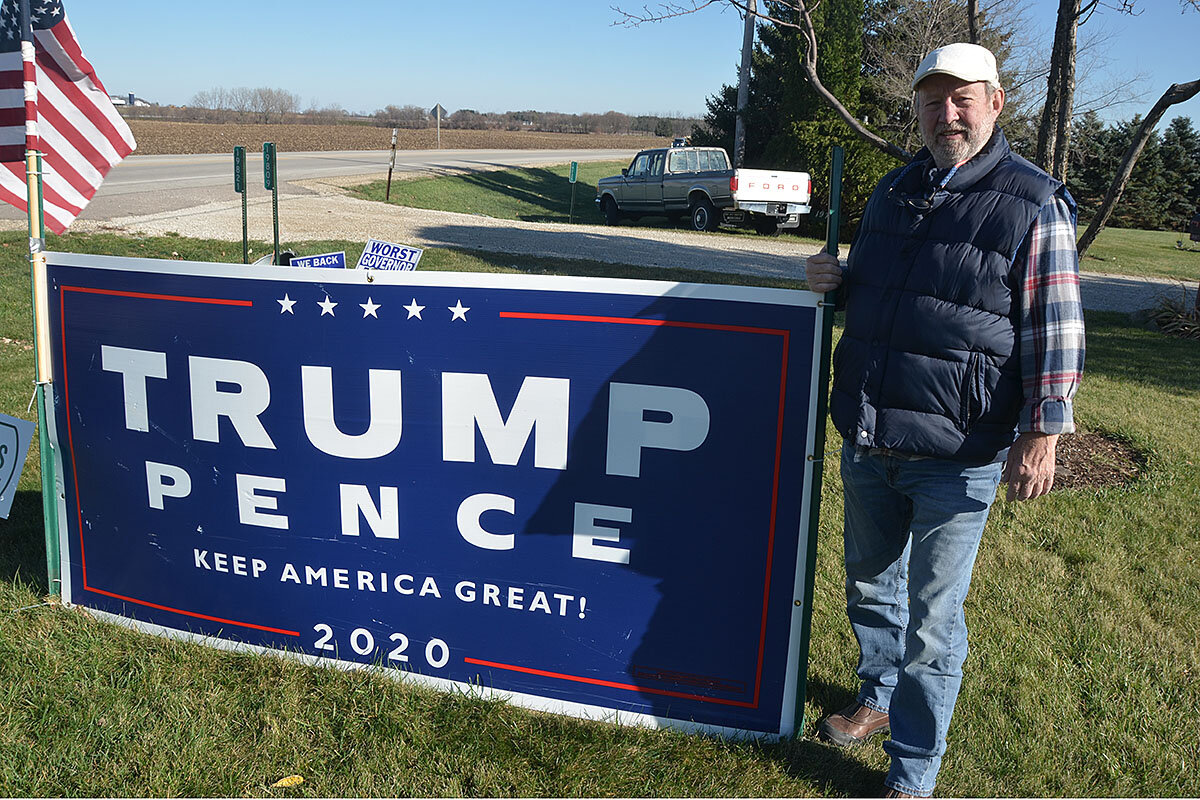
“That’s what we get for sending them to college!” Mr. Ring jokes. But Ms. Ring has the last word. “They’re wonderful human beings,” she says. “We just don’t agree.”
But the Rings’ loyalty to the president sent a sudden jolt through the trust they’ve put into their favored news source. On election night, Fox News was the first to project Mr. Biden the winner of Arizona, just before President Trump was reportedly preparing to declare victory.
“I’ll never listen to the mainstream media again,” says Mr. Ring, sitting at his dining room table with his wife and granddaughter. “And I’ll never listen to Fox again,” he says, though he adds he’ll still watch Tucker Carlson, one of President Trump’s most steadfast defenders. “He’s one of us.”
Such implicit trust and loyalty, as well as the jubilant sense of identity the president often inspires, has been one of the most enduring features of the polarizing presidency of Donald Trump from the start. At least 70% of Republicans said they trusted the president more than news outlets such as The New York Times, The Washington Post, and CNN. But 54% of Republicans also said they’d trust President Trump over Fox News as well, according to a 2017 YouGov poll.
Though he lost the popular vote to Mr. Biden by more than 5 million votes, over 72.5 million Americans voted for President Trump in this year’s election – nearly 10 million more than the number of those who vaulted him to victory in 2016. And according to a Politico/Morning Consult survey of registered voters on Nov. 6-9, some 70% of Republicans, in varying degrees, do not believe the 2020 election was free and fair.
That’s in contrast with the Trump administration itself, with its Cybersecurity and Infrastructure Security Agency releasing a statement Thursday calling the Nov. 3 election “the most secure in American history.” “There is no evidence that any voting system deleted or lost votes, changed votes or was in any way compromised,” it continued, adding that while there were “many unfounded claims and opportunities for misinformation,” voters should turn to election officials for answers.
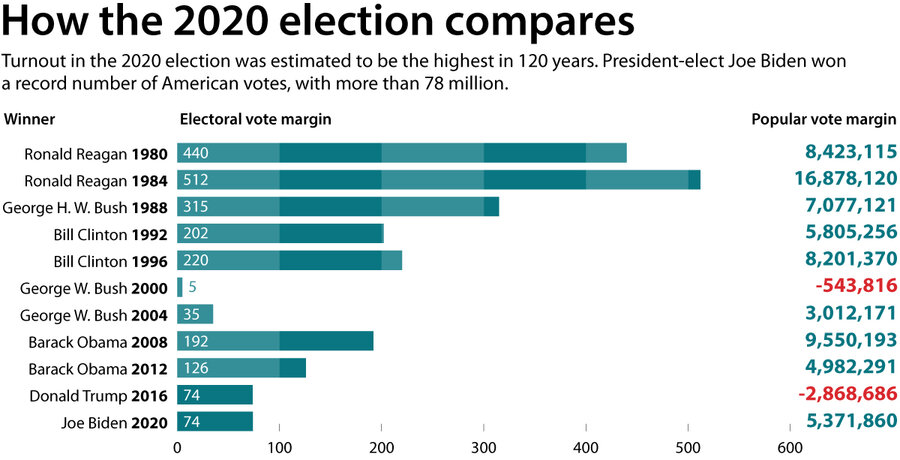
270 to win, Federal Election Commission, Cook Political Report
Media silos and echo chambers
For over a decade, many political observers have expressed growing concern not only with the country’s alarmingly stark political divisions, but also the phenomenon of “media silos” and “echo chambers” that have only seemed to reinforce them, isolating Americans from each other, creating two virtual worlds of competing fact claims and casual dismissals of the other side’s “fake news.”
“What we’re seeing is a widespread lack of trust in the news media and established institutions, which is leading to a rejection of factual information and, beyond that, standards of evidence,” says Katlyn Carter, professor of history at the University of Notre Dame in Indiana.
“It’s a very dangerous situation because there is no quick remedy to rebuild trust when it has eroded to such an extent that not only facts, but the very processes of establishing them, are contested,” says Professor Carter.
The Trump campaign filed a number of lawsuits in the swing states he’s projected to lose, including the so-called blue wall states of Wisconsin, Michigan, and Pennsylvania. As of Friday, the Trump campaign was 1-14 in court, with most judges ruling that the cases lack factual evidence to support claims. In fact, the Trump campaign lawyers have acknowledged in court in two states that they are not alleging voter fraud – let alone widespread voter fraud, as the president claims.
In Arizona on Friday, Trump lawyers asked a judge not to issue a ruling, since the Biden win there rendered a decision unnecessary. Also on Friday, a Michigan judge refused to throw out the certification process for Wayne County, saying, “it would be an unprecedented exercise of judicial activism.”
Moderate Republican officials – such as Sens. Susan Collins, Mitt Romney, Ben Sasse, and Govs. Charlie Baker, Mike DeWine, and Larry Hogan – have already congratulated President-elect Biden on his projected Electoral College victory and record-setting popular vote. And many Republican voters like William Marshall say they do not necessarily believe the president’s unsubstantiated claims of voter fraud.
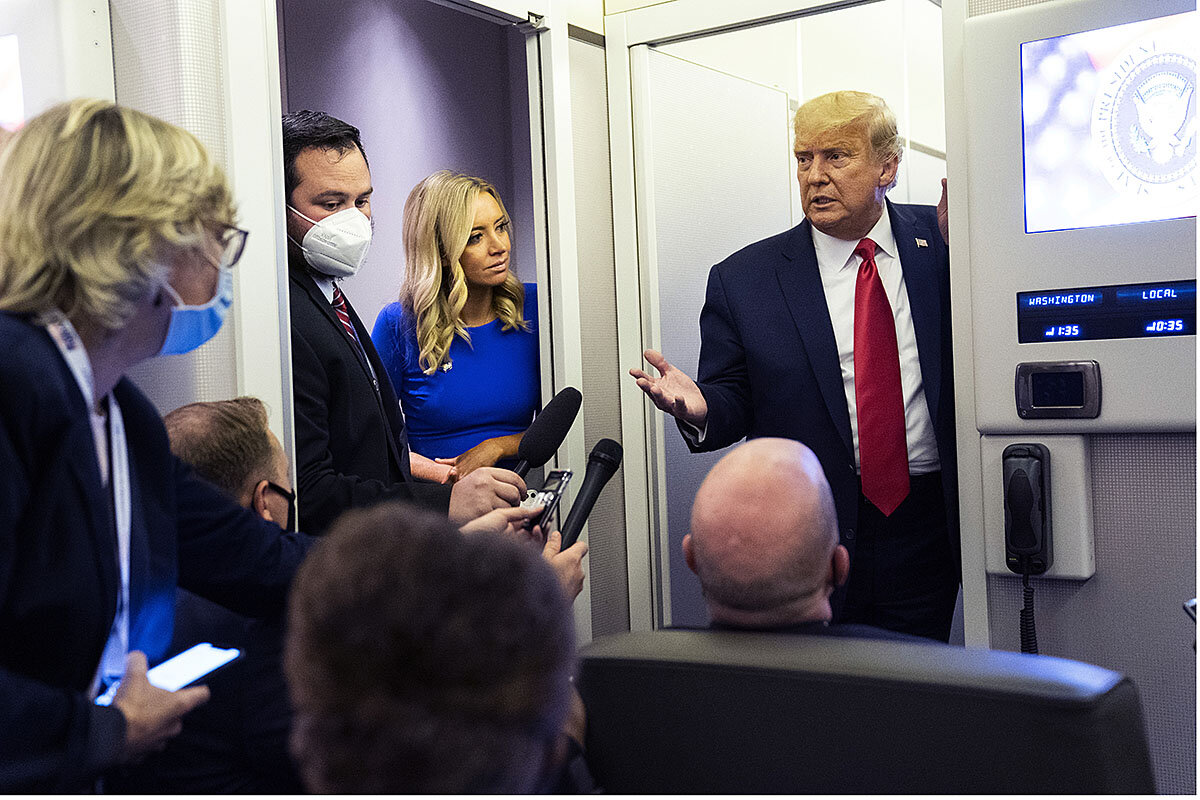
Sitting behind a plexiglass barrier at a rest area on Interstate 94 near Kenosha, where he cheerfully helps guide travelers to their destinations, Mr. Marshall says he’s not surprised President Trump is projected to lose the election. But he’s frustrated with the nation’s cacophony of news sources, and he laments the loss of the trust he once placed in the authoritative news broadcasts of an earlier era.
“Now things have become so politically polarized in the country,” and that has made it very difficult to sort through the dizzying amount of competing factual claims, says Mr. Marshall, a self-described “news junkie” who watches NBC News and sometimes tunes in to CBS and Fox. “It bothers me that there’s no place I can watch the news and find someone who has no agenda.”
Jason Sponaugle, a junior at the University of Cincinnati and president of its chapter of College Republicans, says he has no trust at all in mainstream news media outlets, and he considers both CNN and Fox News to be “entertainment-based” networks dominated by a narrow set of corporate interests and governed by political agendas – a view held by many young progressives as well.
And like many in his generation all across the political spectrum, Mr. Sponaugle, who’s studying politics and finance, has embraced the wide diversity of news sources easily available online, and he says he tries to go straight to the source as often as possible, seeking the statements and websites candidates themselves publish online, and piecing together his understanding of the news through a variety of outlets.
“To be completely honest, I hope I’m wrong [about any potential voter fraud] because the implications of this are massive, but it’s looking more and more like a fix was in in some of these different states,” Mr. Sponaugle says, giving weight to the statements of the Trump campaign.
Trump voters want courts to decide
Yet in many ways, Mr. Sponaugle and other Republican voters say they simply want to allow the president’s claims of voter fraud to be examined in the nation’s courts. “As of right now, nothing’s finalized,” says Mr. Sponaugle. “I think it remains to be seen whether or not President Trump lost this election, and that’s something we’ll find out as the legal process plays on.”
Indeed, there is a silver lining to the number of lawsuits the Trump campaign has filed in state and federal courts, given the profound lack of trust many voters express toward the nation’s mainstream news outlets.
“Elections as an institution need to be viewed as legitimate, which in our case means free, fair, frequent, and transparent,” says Gayle Alberda, professor of politics at Fairfield University in Connecticut. “But we also need the ability for any candidate, whether you’re the winner or the loser, to have an avenue to protest the results.”
“That’s an essential part of a democracy in that it upholds the legitimacy of an election,” Professor Alberda continues. “If the results are finalized, but then I don’t have as a candidate the ability to question those results or seek legal action or ask for a recount, then how do we know that election was valid?”
Given the nation’s generally widespread respect for the court system, these lawsuits can in effect strengthen the country.
“They’re looking at the claims in these court cases, they’re looking at whether or not there was proof, they’re hearing the president’s case if there was widespread fraud,” Professor Alberda says. “And then we can settle those conflicts. ... Will they change the outcome of the election? Probably not, but it does and hopefully it will give the election the validity that it needs after they have exhausted all those options, and all the other country’s institutions have done their job.”
But there remains the wider problem, many scholars say, of the country’s massive media ecosystem unmoored from a common set of facts, and the tremendous amount of faith tens of millions of Americans place in President Trump over traditional and nontraditional news sources.
“Leaders influence the worldview their followers are in, and those worldviews define their private reality,” says Helio Fred Garcia, who teaches professional development and leadership at Columbia University in New York. “Create a worldview in which the media is ‘fake news’ and that science is a deep-state conspiracy, and the evidence suddenly is irrelevant.”
“Leaders who lie persistently create a false worldview for their followers, who cling to those worldviews even when the leader moves on,” continues Mr. Garcia. “So, even after the Bob Woodward recordings revealed that Donald Trump knew that the virus was deadly, airborne, and worse than the flu, his followers kept showing up for rallies unmasked and undistanced,” even as many said they believed the coronavirus was a hoax. “When he said he was cured and that the nation was turning the corner, they continued to believe him and not the objective evidence.”
Many observers, too, say the distrust millions of conservative Americans express toward the news media is only exacerbating the problems surrounding factual information.
Stepping into Parler
Older Republican voters like Ms. and Mr. Ring in Wisconsin – who are even skeptical of sources like Fox News – are turning to alternative and more deeply partisan sources such as the One America News Network, Newsmax, Gateway Pundit, and other sources many say are uncritically friendly to President Trump.
And as Twitter and Facebook have incorporated more aggressive fact-checking policies and warning labels on many of President Trump’s posted claims, Mr. Sponaugle believes these in fact have demonstrated extreme bias against conservative views.
So like the Rings, he recently set up an account on Parler, a social media site that does not block or censor any user information – which has made it a source of wild conspiracy theories and anti-Semitic views, critics say.
Nathan Ireland, a construction foreman and Trump voter who lives in Springfield Township in Ohio, is also considering switching to Parler to get his news, believing the reporting on Fox News during the election “raised some red flags” as it cast doubt on the president’s claims.
“People stick to what they know, who they think they can trust,” says Mr. Ireland. “It’s all about who you trust, which, right now it’s hard to figure out who that is.”

270 to win, Federal Election Commission, Cook Political Report

US, China, Taiwan: Why the tense status quo may stick – for now
For the last few years, headlines about rising tensions over Taiwan have been a steady drumbeat, making it hard to parse which developments are most important. Here’s a reality check on the island’s defense.

- Quick Read
- Deep Read ( 6 Min. )
As the world watched the U.S. presidential election unfold last week, the risks of a distracted Washington were felt in a hot spot halfway around the globe: Taiwan.
The self-ruling, democratic island had its military on high alert during the U.S. vote, its defense minister told lawmakers in Taipei. Beijing frequently vows to reunite Taiwan with mainland China, and concerns over the potential for a military clash have grown as relations between China and the U.S. deteriorate to a low not seen for half a century. Taiwan’s defense deterrent relies, in part, on the expectation that the U.S. would quickly help counter an attack on the island, which Beijing claims as part of its territory.
China’s People’s Liberation Army has stepped up incursions into Taiwan’s defense zone, while Washington accelerates arms sales to Taipei. But despite the elevated tensions, and the risk of conflict sparked by accident, both sides say larger strategic calculations lessen the likelihood of all-out war. For example, China’s military has grown dramatically, but it still lacks the ability to wage its ideal military campaign: a swift, overwhelming attack and successful amphibious landing invasion that would present the world with a fait accompli.
US, China, Taiwan: Why the tense status quo may stick – for now

As the world watched the U.S. presidential election unfold last week, the risks of a distracted Washington were felt perhaps most acutely in a hot spot halfway around the globe: Taiwan.
Taiwan placed its military on high alert during the elections, Taiwan’s Defense Minister Yen Teh-fa told lawmakers in Taipei last Wednesday, saying the island faces a threat from escalating incursions by Chinese warplanes and naval ships into the defensive zone around the island, just 80 miles off mainland China’s coast. The People’s Liberation Army has conducted more than 2,700 air and sea incursions so far this year, Mr. Yen said. PLA aircraft crossed the “median line” – an unofficial line that both sides have traditionally observed in the airspace between Taiwan and mainland China – nearly 50 times, he said, the most since 1990.
Taiwan’s defense deterrent relies in part on the expectation that the U.S. military would quickly help counter an attack by China on the island, a self-ruling democracy that Beijing claims as part of its territory. Washington is also accelerating arms sales aimed at shoring up Taiwan’s defenses, and on Election Day the U.S. State Department approved a $600 million sale to Taiwan of four MQ-9B armed drones and related equipment, which drew a swift rebuke from Beijing. The sale brings the total of U.S. weapon sales to Taiwan approved this year to more than $5 billion.
Concerns have heightened over the potential for a military clash over Taiwan – a strategic flashpoint between the United States and China – especially as relations between the two superpowers deteriorate to a low not seen for half a century. Beijing bristles at the tightening of U.S.-Taiwan ties under the Trump administration, viewing it as part of a broader containment strategy. China’s military pressure on Taiwan, meanwhile, coupled with its crackdown on Hong Kong’s autonomy and its aggressive staking out of claims in the South China Sea and along its disputed border with India, amplifies the risk of a conflict, especially one sparked by accident, military analysts say.
Barring a military mishap, however, and despite the elevated tensions, experts on both sides say larger strategic calculations lessen the likelihood of an all-out war over Taiwan that would trigger conflict between China and the U.S., both nuclear powers. Beijing’s military capabilities – which do not yet guarantee success in an armed takeover – Taiwan’s growing asymmetric defenses, and the prospect of allied intervention all leave Beijing unlikely to use force anytime soon, despite its often-repeated vows to unify, military analysts say. “China is still deterred from using force to reunify because they have no assurance of success,” says Drew Thompson, a former Pentagon official overseeing China policy.
Yet the decidedly tense status quo is growing more so. PLA pilots now cross the median line “with impunity, so that sets up a much more dangerous arrangement where the Taiwanese jets always have to intercept,” says Kharis Templeman, a visiting fellow at the Hoover Institution and a lecturer in East Asian studies at Stanford University. “The Taiwanese are pretty well trained, but … you can imagine them crashing into one another, and the two sides do not have good communications to de-escalate,” he says. For its part, Beijing’s Foreign Ministry spokesman stated in September that the median line is “nonexistent.”
Chinese military analysts agree the risk is high, if for different reasons. “In my opinion, most of the military tensions today are the result of enhanced relations between Taiwan and the United States,” says Lyu Jinghua, a retired PLA colonel and a visiting scholar at the Carnegie Endowment for International Peace. The Taiwan Strait is currently “very dangerous,” Colonel Lyu says, because “the Chinese government has no room to maneuver if the Taiwan crisis escalates. … [It] will have to fight to defend the territory and sovereignty of China.”
New deterrent
China’s military capabilities have grown dramatically over the past 20 years. With “staggering amounts of new military hardware” and improvements in joint operations and combat readiness, Beijing is on track to meet its goals of modernizing the PLA by 2035 and building a “world class” military by 2049, according to the Pentagon’s 2020 China military power report released in September.
Yet China still lacks the ability to wage its ideal military campaign on Taiwan: a swift, overwhelming attack and successful amphibious landing invasion that would present the world with a fait accompli. “Even though it’s a short distance from mainland China to Taiwan, [the PLA] would still have to deal with Taiwan’s defensive capabilities,” such as sea mines, anti-ship cruise missiles, and booby traps, as well as weather and geography that limit China’s options, says Derek Grossman, a senior defense analyst at Rand Corp. who focuses on Indo-Pacific security issues.
“If they failed, it could be the end of Chinese Communist Party rule. It would be seen as so incompetent and embarrassing,” he says.
Another important deterrent is Taiwan’s embrace of a new, asymmetric defense strategy. Faced with the reality of China’s massive military spending – an estimated $250 billion last year compared with Taiwan’s $11 billion – and a stark force imbalance that will only grow, Taiwan is adopting a more nimble, David vs. Goliath approach.
The goal of the new strategy is to take advantage of Taiwan’s geography to fortify the island. “‘Fortress Taiwan’ is really the mantra now at the Pentagon – trying to make Taiwan an impenetrable fortress to Chinese attack is now the key objective,” says Mr. Grossman.
Known as the “Overall Defense Concept,” the strategy “redefines winning the war as foiling the PLA’s mission of successfully invading and exerting political control over Taiwan,” retired Adm. Lee Hsi-min, who developed the concept as chief of staff of Taiwan’s armed forces from 2017 to 2019, explained last week in The Diplomat.
No longer planning for a war of attrition with high-profile, expensive conventional weapons platforms such as fighter jets, tanks, and submarines, the strategy instead relies upon low-cost weapons systems meant to stymie a Chinese invasion, such as minelaying ships and stealthy fast-attack crafts dispersed among fishing boats in the island’s 200 ports, Admiral Lee wrote. It uses camouflage and deception to preserve Taiwan’s forces, combined with large numbers of small, mobile, lethal, and hard-to-target weapons designed for guerrilla warfare, such as precision-guided munitions and cruise missiles, man-portable air-defense systems, and anti-armor weapons.
A wider puzzle
The U.S. is backing the strategy with advanced sales of asymmetric weaponry such as armed drones, and shore-based cruise missiles that can target ships on the fringes of China’s littoral. “That is where China is the weakest,” says Mr. Thompson, who is now visiting senior research fellow at the Lee Kuan Yew School of Public Policy at the National University of Singapore.
“Taiwan has tremendous advantages and is figuring out now how to maximize them,” says Mr. Thompson. “If you are China and looking at what Taiwan has done in the last decade, there is a reason China is deterred,” he says. “The PLA knows it will not be a cake walk, so they are taking a tremendous risk in initiating an invasion.”
China, for its part, has focused much of its effort on trying to counter the anticipated U.S. military intervention in a Taiwan contingency, using area denial weapons such as bombers and a new ship-to-ship, supersonic missile. “The PLA has spent the last 25 years trying to make it as difficult as possible for the U.S. military to move into that air space and sea space without suffering a lot of casualties up front,” says Mr. Templeman. The new ship-to-ship missile expands China’s anti-access area, raising concerns at the Pentagon, he says.
“This is a rare weapon that has a longer range and is more effective than what we have in our own stocks, so it has gotten a lot of attention from our military,” he says. “They don’t like to be outgunned on anything.”
But experts on both sides of the strait point to encouraging signs that all parties can avoid confrontation in the first place – such as the existence of functioning military communications mechanisms at multiple levels between Washington and Beijing.
Despite increasing tensions, “the two militaries are very conscious of their communications and so they are still holding consultations” as planned, says Colonel Lyu. “The number of dangerous incidents between the planes and ships are actually decreasing” since 2014, when the PLA and Pentagon signed agreements to create confidence-building measures, she says. Those memorandums “are playing a very positive role in preventing a crisis.”

On college campuses, one surprising relief from pandemic stress: friends
Across college campuses, students and mental health providers alike are feeling stretched by the pandemic. Yet both groups are coming up with solutions – from telehealth and apps to good, old-fashioned camaraderie.
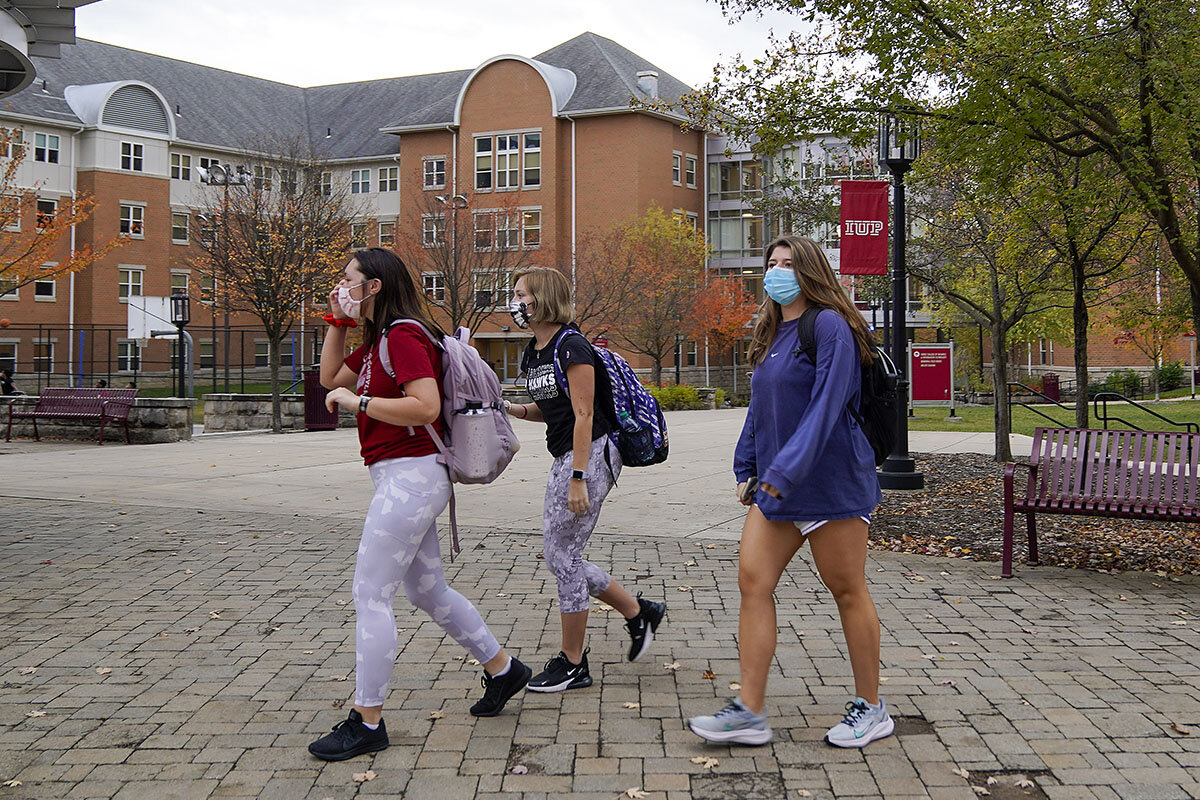
- Quick Read
- Deep Read ( 5 Min. )
As with millions of students, the pandemic has radically disrupted college life for Olivia Kane, a freshman at Niagara University in New York. Still, she carries on – rehearsing with a transparent mask in theater class and practicing dance moves remotely over Zoom.
Such perseverance is becoming all the more necessary, especially for people Ms. Kane’s age. Even before the pandemic, research among younger adults showed a rise in anxiety, depression, suicidal ideation – and a corresponding jump in demand for college mental health services, says Laura Horne, program director at Active Minds.
That jump has since become a leap.
In response, campus mental health centers nationwide have invested in a variety of student support services, from expanded telehealth access to wellness apps.
Students themselves are stepping up, too. Rachel Bradley, a senior at Cornell University, leads Cornell Minds Matter, a student mental health group. She also works as a peer counselor
Informal peer support is making a big difference as well. From roommates quarantined together to friends spread out across colleges, students are supporting each other.
“You’re going to get through this,” Ms. Kane tells her friend at another New York university. “We all are.”
On college campuses, one surprising relief from pandemic stress: friends
Olivia Kane sat in her parked car, wondering what to do. She had just come from an abruptly canceled speech class, after her professor announced that two students had tested positive for COVID-19 and the class may have been exposed. Go to the health center, the professor said, and go home.
But Ms. Kane didn’t know if she could. A commuter student, she lives with her family, and her dad is considered high risk for the virus. What if she brought it back to him?
After an hour undecided at the wheel, she drove home and quarantined in her brother’s room. She exited days later symptom-free, but shell-shocked.
That experience crystallized the semester for Ms. Kane, a freshman theater major at Niagara University in New York. For her, as for millions of other students, the coronavirus has radically disrupted college life. Still, she carries on – rehearsing with a transparent mask in theater class and practicing dance moves remotely over Zoom.
Such perseverance is becoming all the more necessary, especially for people Ms. Kane’s age. More than ever, experts say, this moment demands a commitment to resilience and to that sense of camaraderie born out of collective trauma.
“A really positive thing since the pandemic is that we can all relate to some degree of what it’s like for people who struggle every day due to mental health challenges” such as depression, anxiety, and distress, says Laura Horne, program director at Active Minds.
Younger adults make up an almost paradoxical demographic when it comes to the effects of COVID-19. They’re among the least vulnerable to its physical risks and among the most vulnerable to its mental ones. And since March, they’ve been at the fore of concerning trends in mental health, which experts say have now evolved into a national crisis.

Campuses respond to worsening trends
Even before the pandemic, research among younger adults showed a rise in anxiety, depression, suicidal ideation – and a corresponding jump in demand for college mental health services, says Ms. Horne.
But that jump has since become a leap. Since March, per Active Minds’ research, some 80% of young people say their mental health has worsened. In a midsummer Centers for Disease Control and Prevention survey, more than 62% of 16- to 24-year-olds reported anxiety or depression. Around a quarter said they had seriously considered suicide in the last month.
Such startling numbers are the end of a complex function. The pandemic has inflicted physical harm nationwide. In turn, that threat of physical harm has limited in-person contact with mental health providers and forced arduous adaptations to virtual platforms. In effect, mental and physical health have become something of a zero-sum game.
And the longer that game lasts, the more difficult its effects are to treat, says John Blackshear, dean of students in Student Affairs at Duke University and a clinical psychologist.
Like many other colleges early this year, says Dr. Blackshear, Duke thought the pandemic would be an acute crisis, enormously disruptive but isolated in time. But as the pandemic proves more elastic, and students’ stress persists, mental health staff are being stretched like never before.
In response, universities nationwide have invested in a range of student support services:
- Expanded telehealth access, allowing for virtual counseling
- Wellness app licenses for therapeutic activities like meditation
- Increased publicity of available mental health resources, helping drive student awareness to record-high rates
They’ve also tried to smooth the transition to virtual learning. A sense of continuity during online education, says Dr. Blackshear, helps limit the logistical stressors of college during the pandemic and keep students from feeling overwhelmed.
Students step up for each other
At the individual level, this semester of discontent has been a crucible for students, as well, while they adjust to adulthood in the context of chaos.
That’s where one of the most encouraging trends of this year fits, says Ms. Horne. Students are relying on friends for support more than ever – friends like Rachel Bradley.
Ms. Bradley, a senior at Cornell University, leads Cornell Minds Matter, a student mental health group. She and other students have spent the semester hosting campus events and performing small acts of encouragement. Motivated by her own experience in therapy, Ms. Bradley also works as a peer counselor for students who need the relief of a listening ear.
Peer support works informally too. At least it has for Julia Cheng, a freshman at James Madison University in Harrisonburg, Virginia.
Early in the semester, insufficient safety protocols and student parties led to a campus coronavirus outbreak. But as JMU sent students home, Ms. Cheng applied for special permission to stay, since she lives with a grandparent. For the same reason, her roommate did too.
College hasn’t been what Ms. Cheng expected, but the friendship made possible by countless hours in quarantine together has kept her happy and helped her adjust. The semester, she says, has even been good for her mental health.
Others were less fortunate.
Declan Downey, another JMU freshman, returned home when campus closed, disappointed in the lack of student accountability and with little to do.
“It was pretty much just school, sleep, and work,” he says.
JMU has since allowed students to return, and while Mr. Downey enjoys being back on campus, he still feels a sense of loss. Friends help, but at a certain point mental health professionals may be better equipped to meet student needs, he says.
Camaraderie in common struggles
Along with promoting de-stressing outlets, reliable routines, and clinical support if necessary, mental health professionals recognize the need for a stronger sense of camaraderie in this lengthening crisis.
“Connectedness and a sense of belonging [are] so crucial in any kind of crisis situation,” says Joy Himmel, a therapist with the American College Health Association.
The ideal is for students to practice self-care and stay aware of their needs in the moment, says Ms. Himmel. Maybe, though, self-care, when so many people face the same challenges, involves staying aware of others as well.
Ms. Kane, at Niagara University, thinks so.
When she’s not watching “The Office” or listening to 60s music to relax, she calls a friend from high school – also a freshman theater student but at a different college in New York.
“The advice I … give to her is, obviously, stay strong,” Ms. Kane says. “You’re going to get through this,” she tells her friend. “We all are.”
Editor’s note: As a public service, we have removed our paywall for all pandemic-related stories.

Difference-maker
Black, trans, and hopeful. Meet Jevon Martin (video)
For many in the Black transgender community, life has long felt safer in the shadows. But for Jevon Martin, at least, there is hope in being seen.
Jevon Martin found his purpose in life early. “To help and to be of service,” he says. “I know that’s my purpose.”
That has often meant welcoming people who have nowhere to go into his home. “I almost got evicted for having too many people in my apartment,” he says. “So I said, let me start a nonprofit.”
At Princess Janae Place, Mr. Martin helps members of New York’s Black transgender community who are experiencing homelessness navigate the transition to stable housing.
As a Black transgender man himself, Mr. Martin has seen many of the unique struggles facing this community up close. Homelessness is widespread. Shelters promise roof and a bed, but they offer little security for those perceived as different. Mistreatment is also pervasive.
But lately, Mr. Martin has found new cause for hope as the trans community has taken to the streets in recent months to call attention to the challenges it faces.
“Just seeing the amount of people come out and support the trans community ... it lifted my spirit,” he says. “It made me feel that we are being seen.” – Alva French, correspondent
Black, trans, and hopeful. Meet Jevon Martin.

Book review
Bank shot: A sports writer and a superfan bond over Knicks basketball
Sometimes it really is about who you know. Having a mentor with the right connections, who also acts as a confidant and friend, can make a lasting difference in a life.

- Quick Read
- Deep Read ( 3 Min. )
-
By Olive Fellows Correspondent
Michelle Musler’s seats were located right behind the Knicks bench, allowing her an up-close view of the action and relationships with many important figures attached to the team. This meant that she was privy to valuable insider knowledge, and her near-constant presence at Madison Square Garden guaranteed that she would cross paths with sports writer Harvey Araton. The two became acquainted in the early 1980s, when he was an up-and-coming sports writer covering games for various New York publications.
Musler wore many hats in her friendship with Araton. She started off as a reliable source for his stories and eventual column for The New York Times, but she was also a trusted confidant, a mentor, a cheerleader, and even a kind of mother figure.
Bank shot: A sports writer and a superfan bond over Knicks basketball

They bonded over New York Knicks basketball, sitting courtside in Madison Square Garden. He was an up-and-coming sports writer, and she was a superfan and the single mother of five. The heart of their friendship was a love for the game. In his memoir, “Our Last Season: A Writer, A Fan, A Friendship,” Harvey Araton, who went on to write for The New York Times, shares the story of his decadeslong friendship with Michelle Musler.
Musler was an unlikely basketball enthusiast. She became a single mother in her early 30s and only by fortuitous circumstances and sheer willpower was she able to go from worrying about paying her bills to running a successful consulting company. Her business provided her family with a stable life, and herself with a treasured pair of Knicks season tickets.
Her seats were located right behind the Knicks bench, allowing her an up-close view of the action and, largely because of her personable nature, relationships with many important figures attached to the team. This meant that Musler was privy to valuable insider knowledge, and her near-constant presence at Madison Square Garden guaranteed that she would cross paths with Araton. The two became acquainted in the early 1980s, when Araton was an up-and-coming sports writer covering games for various New York publications. Musler began feeding Araton tips that often gave him the scoop on a story or an angle that beefed up his pieces.
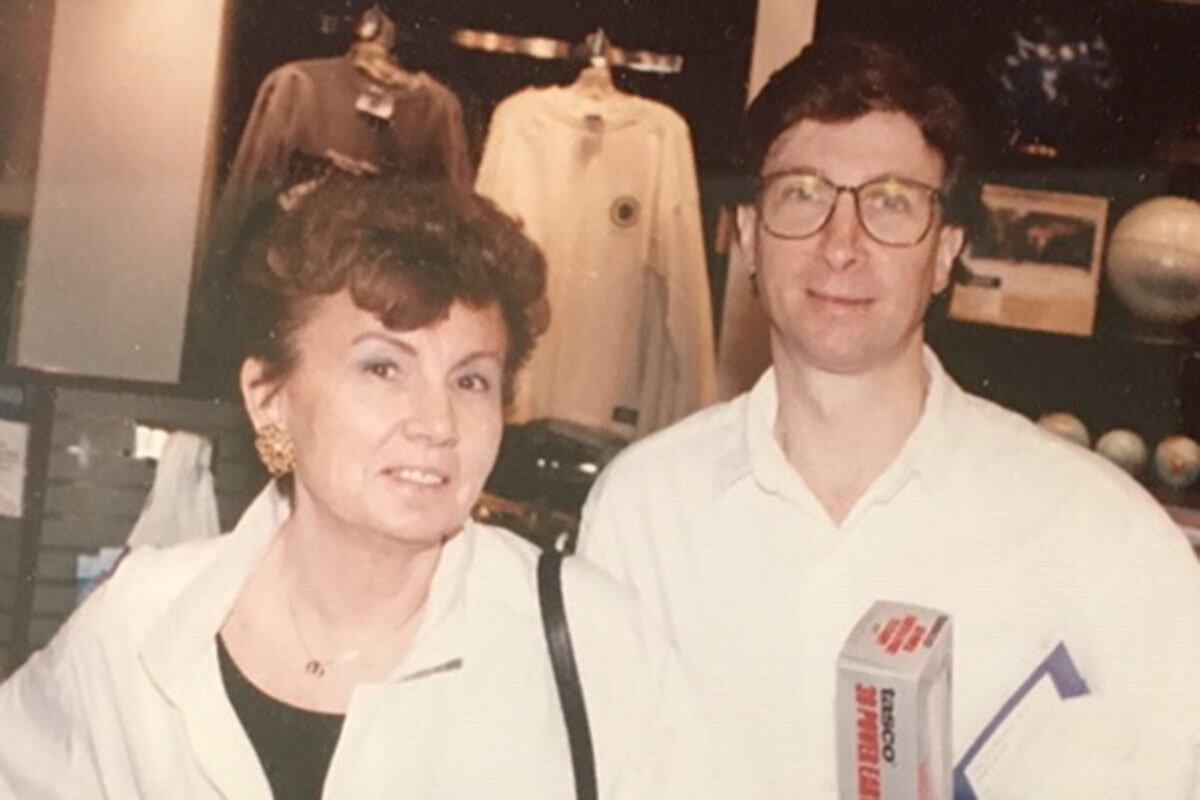
Musler wore many hats in her friendship with Araton. She started off as a reliable source for his stories and eventual column for the Times, but she was also a trusted confidant, a mentor, a cheerleader, and even a kind of mother figure. The special attachment they shared lasted until her death in 2018.
In addition to personal details about their lives, the journalist discusses what he and Musler bonded over in the first place: Knicks basketball. He covers several eras of the franchise – mainly in the 1970s through his last shared season with Musler in 2017-18. While much of the information will allow non-basketball fans to feel part of the action, he allows the level of Knicks-specific detail to bubble up to the point of inaccessibility to those not familiar with the sport, stopping short of being truly excessive.
Looking beyond that, the book is downright charming and comes off precisely as intended: a tribute to a remarkable woman who played a tremendous role in the life of the author, and who was a largely unknown but highly influential on-the-sidelines figure during this period of Knicks basketball.
This is a memoir about life as much as about sports, although the ever-wise Musler would have likely argued that the two are inherently connected. As Araton recalls, she “loved sports because she always thought a single game, segmented into stages, was a microcosm of life, with a beginning, a middle, and an end.”

So, too, it seems, can memoirs encapsulate our lives, in which endings frequently prove bittersweet.
The author concludes by writing a touching letter to Musler, first bringing her up to date on the latest Knicks news she would be eager to hear, and informing her of the abrupt halt to sports as we know them while the world grapples with the coronavirus. But most importantly, in the letter he thanks her for the contributions to his life and work, and for the friendship that so deeply enriched his life.
This heartfelt story of friendship is one to be savored.
Other headline stories we’re watching
(Get live updates throughout the day.)The Monitor's View
Ethiopia’s road to war needs an offramp
- Quick Read
- Deep Read ( 3 Min. )
-
By the Monitor's Editorial Board
Democracies thrive best when they protect minority interests. In Ethiopia, that condition has degraded in the past two years – ironically under the most pro-democracy leadership in the country’s history. Now Africa’s second-most-populous country has an armed conflict on its hands between a key minority, the ethnic Tigray who held power for decades, and a government trying to unify the country. What happens next may determine if democratic reforms made since 2018 are uprooted and whether the Horn of Africa – already fragile – becomes more unstable.
Ethnic strife has been a stubborn source of instability in Ethiopia. After Abiy Ahmed was chosen as prime minister two years ago, he vowed to entrench democratic norms. But Tigrayans have felt increasingly aggrieved by his agenda. He reconfigured the ruling coalition into a new party to include minorities that had long felt left out. Prominent Tigrayan officials lost key positions in the shuffle.
To achieve peace and democracy, Ethiopian government must be based on more than a power balance of ethnic groups. Reversing the drift toward war and forging a shared national identity starts with finding new ways of achieving inclusiveness. Violence is not one of them.
Ethiopia’s road to war needs an offramp
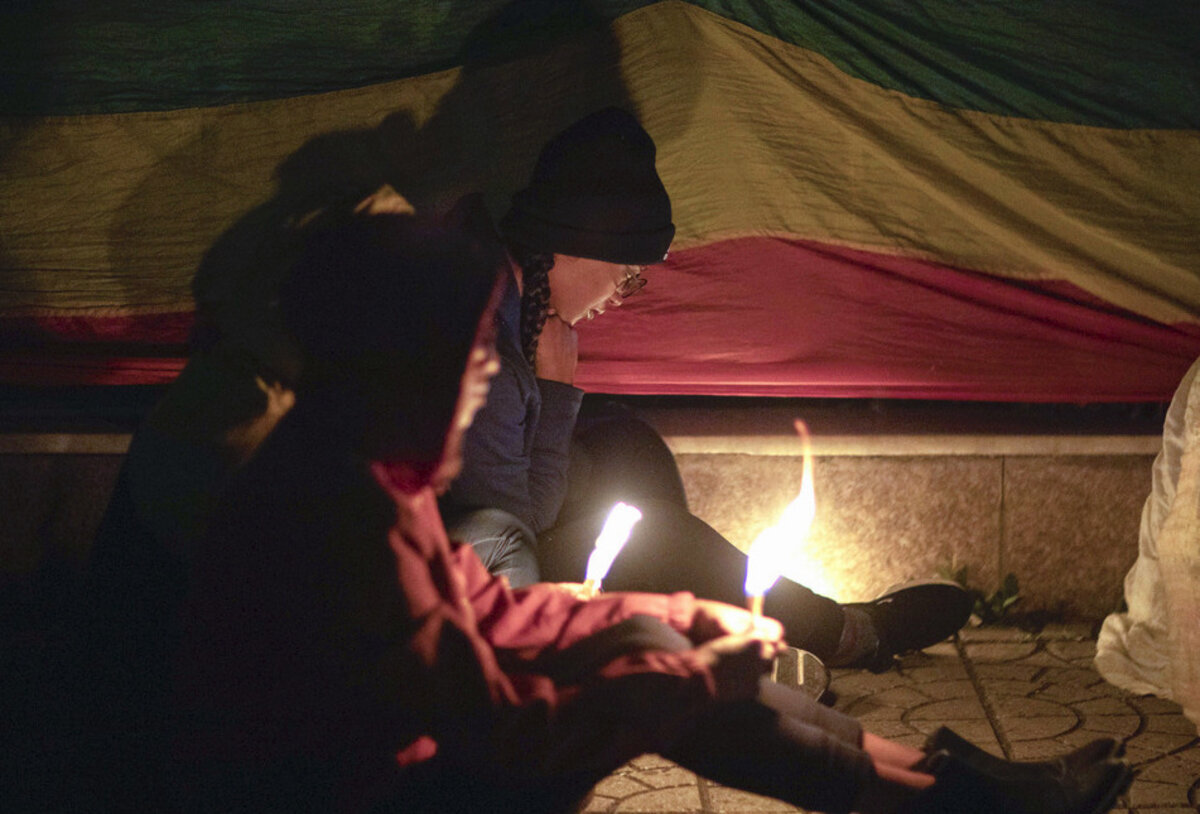
Democracies thrive best when they protect minority interests. In Ethiopia, that condition has degraded in the past two years – ironically under the most pro-democracy leadership in the country’s history. Now Africa’s second-most-populous country has an armed conflict on its hands between a key minority, the ethnic Tigray who held power for decades, and a government trying to unify the country.
What happens next may determine if democratic reforms made since 2018 are uprooted and whether the Horn of Africa – already fragile – becomes more unstable.
The fighting in Tigray cannot be ignored. Amnesty International confirmed that “scores, and likely hundreds” of civilians were killed in a massacre in the town of Mai-Kadra in the northern province of Tigray on Monday. And since conflict broke out Nov. 4, some 11,000 refugees have crossed into Sudan and another 20,000 are at the border.
It is too soon to say whether Ethiopia is descending into full-scale civil war. Information from Tigray is difficult to obtain. The government has cut internet and telephone networks in the region. Air and land corridors have been shut. Prime Minister Abiy Ahmed has imposed a six-month state of emergency in Tigray and the federal parliament has appointed a new regional executive. An arrest warrant has been issued for Tigray’s elected leader, Debretsion Gebremichael.
A war in the heart of Africa’s horn could have wider consequences. The seat of the 55-member African Union, Ethiopia is the leading contributor of soldiers to peacekeeping missions in neighboring Sudan, South Sudan, and Somalia. And its conflict comes at a time of deepening tensions with Egypt over Ethiopia’s nearly-complete dam on the Blue Nile River.
“A protracted internal conflict will inflict devastating damage on both Tigray and Ethiopia as a whole, undoing years of vital development progress,” says United Nations High Commissioner for Human Rights Michelle Bachelet. “It could, in addition, all too easily spill across borders, potentially destabilizing the whole sub-region.”
Ethnic strife has been a stubborn source of instability in Ethiopia. In 1995, after decades of dictatorship, it adopted a constitution establishing a federal system that divided power between a national government and 10 ethnic regions. That structure provided stability and prosperity. But it belied underlying tensions. Federal power remained dominated by the Tigray, who comprise just 7% of the population.
That changed after Dr. Abiy was chosen as prime minister two years ago. He belongs to the Oromo, Ethiopia’s largest ethnic group, and holds a doctorate in peace and security studies. He has vowed to entrench democratic norms. But Tigrayans have felt increasingly aggrieved by his agenda. He has negotiated a peace deal with Eritrea that won him a Nobel Peace Prize but also sidelined the Tigrayan leadership (Tigray borders Eritrea). He reconfigured the ruling coalition into a new party to include minorities that had long felt left out. Prominent Tigrayan officials lost key positions in the shuffle.
The rift opened wider in September. After Dr. Abiy postponed national elections due to the COVID-19 pandemic, Tigray held its own regional ballot. The federal parliament ruled the election unconstitutional. Mr. Gebremichael, for his part, views the federal government, whose term expired in September, as lacking a mandate.
Prior to winning the Nobel prize, Dr. Abiy published a book entitled “Medemer,” an Amharic term translated variously as “addition” and “coming together.” That idea guided him in making peace across borders. The question now is whether he can apply it at home. To achieve peace and democracy, Ethiopian government must be based on more than a power balance of ethnic groups. Reversing the drift toward war and forging a shared national identity starts with finding new ways of achieving inclusiveness. Violence is not one of them.

A Christian Science Perspective
Each weekday, the Monitor includes one clearly labeled religious article offering spiritual insight on contemporary issues, including the news. The publication – in its various forms – is produced for anyone who cares about the progress of the human endeavor around the world and seeks news reported with compassion, intelligence, and an essentially constructive lens. For many, that caring has religious roots. For many, it does not. The Monitor has always embraced both audiences. The Monitor is owned by a church – The First Church of Christ, Scientist, in Boston – whose founder was concerned with both the state of the world and the quality of available news.
‘Love that never fails’
- Quick Read
- Read or Listen ( 1 Min. )
Many are yearning for greater love, hope, and grace in the world. Here’s a hymn that points to the presence and power of God, infinite Love, “a light outshining midday sun / However dark the day.” (Read it or listen to the hymn being sung.)
‘Love that never fails’
There is a presence walks with us
On every pathless way,
A light outshining midday sun
However dark the day.
We reach our hand – and feel God near;
We cry – and She replies.
We open eyes that sense had dimmed;
We stretch our wings and rise
Above the mist, above the dark,
Above the threats of fear,
Upheld by Love that never fails
And is forever near.
We cannot stray beyond Love’s care,
For Love does fill all space;
And where we go the path is marked
By angels of Love’s grace.
– Kathryn Paulson Grounds, “Christian Science Hymnal: Hymns 430-603,” No. 587, © CSBD
Audio attribution:
Words © 1988 The Christian Science Board of Directors
Recording © 2017 The Christian Science Publishing Society
Some more great ideas! To read or listen to a poem in The Christian Science Journal titled “God's love is infinite,” please click through to www.JSH-Online.com. There is no paywall for this content.

A message of love
The beauty under our feet

A look ahead
Thank you for joining us. Please come back Monday, when Monitor writer Christa Case Bryant examines claims of fraud in the 2020 election.



